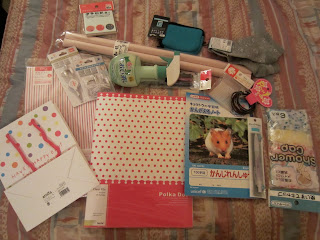Minato Mirai means 'Future Harbour' (minato = harbour), and it's just that - a harbour, with lots of modern buildings and development. The architecture and landscape is distinctive; if you see a picture of it, you immediately know 'this is Yokohama'.
For example, you have the Landmark Tower. This is essentially the tallest 'proper' building in Japan, barring a couple of towers like Tokyo Tower and Tokyo Sky Tree. By the Landmark Tower is Queen's Square, a series of three buildings that taper downwards, getting steadily shorter and narrower. There's also the hotel, Intercontinental Yokohama, which stands right on the harbour's edge and has a distinctive sail-like shape.
View from near Landmark Tower in cherry blossom time. Here's the Nippon Maru (a ship which also houses a maritime museum; behind it can be seen the Intercontinental and Cosmo World)
Colette Mare and Landmark Tower, as seen from outside Sakuragicho station
If you continue walking from World Porters, you'll get to 'Akarenga' (the 'Red Brick Warehouse'), past the cruise ship terminal, and eventually, to Yamashita Park and Chinatown. If you like walking a lot, you could therefore do one big walking trail of most of Yokohama's tourist attractions. If you want to explore each area properly, I would recommend doing Minato Mirai on one day and the whole Chinatown area on another day, just so you can spend more time in each place without getting footsore. If it's a weekend and the weather is nice, the whole area will be lively and full of people enjoying themselves.
Some of the things you can do here:
-go up to the top of the Landmark Tower to enjoy a view of Yokohama from above
-go to the art museum (go to the space between the Landmark Tower and first Queen's Square building, then walk for a minute or two away from the harbour.)
-go on rides at Cosmo World, or play arcade games. The huge Ferris wheel - 'Cosmo clock' - is a good tourist attraction
-go shopping - Colette Mare and World Porters are particularly good for this, in terms of number and range of stores
-catch a movie at Colette Mare or World Porters
-go to Manyo no Yu - it's a building behind World Porters and Cosmo World - where you can have a real hot spring experience in Yokohama. The water is real hot spring water, piped in from Atami and Yugawara. It's more expensive than a run-of-the-mill onsen, but you can experience several different types of bath, including a shared-sex foot bath on the top of the building, where you can see a great view over the harbour.
-sit and relax on the grass on Kishamichi or outside the Nippon Maru (ship out front of the Landmark Tower).
-take a boat ride; for example, boats go from Minato Mirai to Yamashita Park.
Colette Mare is a new building - it wasn't there a year ago. It literally filled a gap in the market. There weren't many good shops right by Sakuragicho station. Yes, Landmark Tower and Queen's Square have shops, and quite a few of them, but these buildings, though cool, have a rather vast, cavernous feel - they don't have the same density of shops as your typical department store. And Landmark doesn't have many shops to appeal to the average Joe. But your tastes may differ.
Minato Mirai is nice for a variety of reasons, but for me, its number one advantage is you feel like you can get some fresh air and open space, which is important when you live in a huge metropolis like the Greater Tokyo area. While there are a lot of buildings around the harbour, it's one of the few places in the city where you can actually sit near the ocean and look out and not feel claustrophobic. There are places to sit on the grass, places to stroll around, places to have a nice coffee.
To see it, go to JR Sakuragicho station (on the Keihin-Tohoku/Negishi line and Yokohama line). You can also go to 'Minato Mirai' station (on the Minato Mirai line), which is located in the basement of the Queen's Square buildings.










